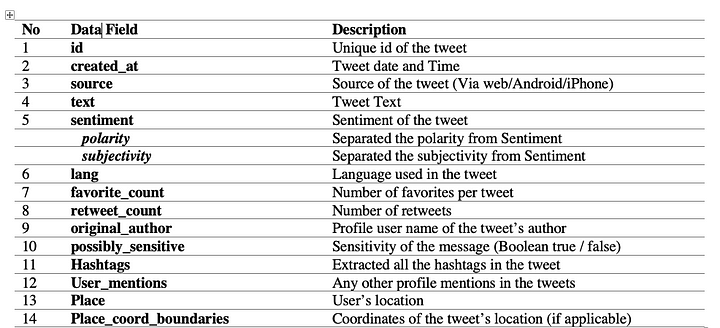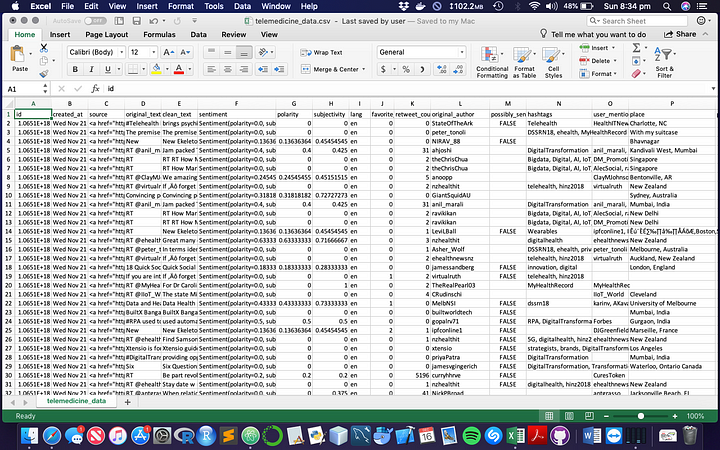Twitter is a gold mine of data. Unlike other social platforms, almost every user’s tweets are completely public and pullable. This is a huge plus if you’re trying to get a large amount of data to run analytics on. Twitter data is also pretty specific. Twitter’s API allows you to do complex queries like pulling every tweet about a certain topic within the last twenty minutes or pull a certain user’s non-retweeted tweets. [Source: https://chatbotslife.com/twitter-data-mining-a-guide-to-big-data-analytics-using-python-4efc8ccfa219]
Hereby in this article, I’ll guide you through the steps I did to extract three sets of Twitter data uniquely separated by three sets of keywords + hashtags. In simple terms, This provides you the python code to extract data from Twitter (Complete twitter data mining tutorial)
If you come up to find any issues in the code feel free to ask
1. Import Libraries
from tweepy import Stream
from tweepy import OAuthHandler
from tweepy.streaming import StreamListener
import json
import pandas as pd
import csv
import re #regular expressionfrom textblob import TextBlob
import string
import preprocessor as p
2. Twitter credentials
If you have no Idea what these twitter credentials are, you must become a twitter developer to use these and I’m sure you’ll find plenty of tutorials when you and also youtube got heaps of videos of how to do this.
#Twitter credentials for the app
consumer_key = 'xxxxx'
consumer_secret = 'xxxx'
access_key= 'xxxx'
access_secret = 'xxxx'
3. Credentials
Pass these credentials to Tweepy’s OAuthHandler instance named ‘auth’, then using that instance call the method set_access_token by passing the above-created access_key and, access_secret.
#pass twitter credentials to tweepyauth = tweepy.OAuthHandler(consumer_key, consumer_secret)
auth.set_access_token(access_key, access_secret)
api = tweepy.API(auth)
4. What do we extract from Twitter and Why do we extract data?
Ok, First things are done. I’ll quickly disclose what I’m attempting to extricate from twitter and will reveal to you a little anecdote about that. I’m trying to connect the relation between two issues and a practical solution to both of those issues by using Twitter data.
Two major diseases were taken as my two issues: Heart Stroke Twitter data & Epilepsy twitter data
Solution: Telemedicine
Simply keep the picture in your mind and in the long run you’ll understand what I’m trying to explain here.

5. Create file paths for the 3 CSV files (to store the data extracted)
#declare file paths as follows for three filestelemedicine_tweets = "data/telemedicine_data_extraction/telemedicine_data.csv"epilepsy_tweets = "data/telemedicine_data_extraction/epilepsy_data.csv"heart_stroke_tweets = "data/telemedicine_data_extraction/heart_stroke_tweets_data.csv"
6. What exactly do we need to extract? (schema of the data we extract from Twitter)
Columns, Yes I meant that. Which columns do we need the most for our analysis?

#columns of the csv fileCOLS = ['id', 'created_at', 'source', 'original_text','clean_text', 'sentiment','polarity','subjectivity', 'lang',
'favorite_count', 'retweet_count', 'original_author', 'possibly_sensitive', 'hashtags',
'user_mentions', 'place', 'place_coord_boundaries']
7. Handle Emoticons and Emojis (cleaning Twitter data using python)
7.1 Emoticons: Let’s declare a series of emoticons (Happy & Sad) because we don’t need the old-school emoticons in the middle of a sentence blocking us against our sentiment analysis.
#HappyEmoticons
emoticons_happy = set([
':-)', ':)', ';)', ':o)', ':]', ':3', ':c)', ':>', '=]', '8)', '=)', ':}',
':^)', ':-D', ':D', '8-D', '8D', 'x-D', 'xD', 'X-D', 'XD', '=-D', '=D',
'=-3', '=3', ':-))', ":'-)", ":')", ':*', ':^*', '>:P', ':-P', ':P', 'X-P',
'x-p', 'xp', 'XP', ':-p', ':p', '=p', ':-b', ':b', '>:)', '>;)', '>:-)',
'<3'
])# Sad Emoticons
emoticons_sad = set([
':L', ':-/', '>:/', ':S', '>:[', ':@', ':-(', ':[', ':-||', '=L', ':<',
':-[', ':-<', '=\\', '=/', '>:(', ':(', '>.<', ":'-(", ":'(", ':\\', ':-c',
':c', ':{', '>:\\', ';('
])7.2 Emoji Recognition (cleaning Twitter data using python)
Because that’s a must, nowadays people don’t tweet without emojis, as in a matter of fact it became another language, especially between teenagers so have to come up with a plan to do so.
#Emoji patterns
emoji_pattern = re.compile("["
u"\U0001F600-\U0001F64F" # emoticons
u"\U0001F300-\U0001F5FF" # symbols & pictographs
u"\U0001F680-\U0001F6FF" # transport & map symbols
u"\U0001F1E0-\U0001F1FF" # flags (iOS)
u"\U00002702-\U000027B0"
u"\U000024C2-\U0001F251"
"]+", flags=re.UNICODE)And then we combine both happy and sad emoticon array-lists first:
#combine sad and happy emoticonsemoticons = emoticons_happy.union(emoticons_sad)
8. Method to Clean (Preprocessor)
Preprocessing here is done by two methods:
Method1: Using tweet-preprocessor Preprocessor is a preprocessing library for tweet data written in Python. When building Machine Learning systems based on tweet data, a preprocessing is required. This library makes it easy to clean, parse or tokenize the tweets.
Method2: I’ve manually defined a function to double check and our tweet preprocessing and it’s always better to be sure that our data is cleaned 100%.
8.1 Method-1
import preprocessor as pPS: I have already imported this in Step 1 (Import Libraries section)
Example:
clean_text = p.clean(twitter_text)8.2 Method-2
Declare a method called clean_tweets(tweet) and this method will clean some remains of the twitter data which is left undone by tweet-preprocessor and double check emoticons and emoji’s because some older version of mobile’s emoticons is not supported in tweet preprocessor’s clean method (Method1).
def clean_tweets(tweet):
stop_words = set(stopwords.words('english'))
word_tokens = word_tokenize(tweet)#after tweepy preprocessing the colon symbol left remain after #removing mentions
tweet = re.sub(r':', '', tweet)
tweet = re.sub(r'…', '', tweet)
#replace consecutive non-ASCII characters with a space
tweet = re.sub(r'[^\x00-\x7F]+',' ', tweet)#remove emojis from tweet
tweet = emoji_pattern.sub(r'', tweet)#filter using NLTK library append it to a string
filtered_tweet = [w for w in word_tokens if not w in stop_words]
filtered_tweet = []#looping through conditions
for w in word_tokens:
#check tokens against stop words , emoticons and punctuations
if w not in stop_words and w not in emoticons and w not in string.punctuation:
filtered_tweet.append(w)
return ' '.join(filtered_tweet)
#print(word_tokens)
#print(filtered_sentence)return tweetAt this point, I want you to give your attention on Stop Words, and why is it important for Text Mining. And for now, Don’t look at the code inside our method, you can see and try to understand this at the end of Step-9
9. Extract Tweets (data collection using twitter)
To connect to Twitter’s API, we will be using a Python library called Tweepy, which is an excellently supported tool for accessing the Twitter API. It supports Python 2.6, 2.7, 3.3, 3.4, 3.5, and 3.6. There are some other Twitter API’s also but I recommend Tweepy since it never gave any trouble.
I’ll post the full code below and section each important part and describe what that part is for:
9.1 Beginning of the method
def write_tweets(keyword, file):
#If the file exists, then read the existing data from the CSV file.
if os.path.exists(file):
df = pd.read_csv(file, header=0)
else:
df = pd.DataFrame(columns=COLS)
#page attribute in tweepy.cursor and iteration
for page in tweepy.Cursor(api.search, q=keyword,
count=200, include_rts=False,In this method, I’ve created two parameters; one for the file name hence we have three different files to take care of as well as three sets of keywords for those file to be filled with which explains the second parameter.
9.2 JSON
The result you receive from the Twitter API is in a JSON format and has quite an amount of information attached.
for status in page:
new_entry = []
status = status._jsonif status['lang'] != 'en':
continueWe create this array of string name new_entry=[] to store all the JSON parsed data on each iteration. and we continue to retrieve data only and if the language is English since I don’t need any trouble translating tweet language to language at this stage. :)
9.3 Replace RT’s and FAVs
*when running the code, below code replaces the retweet amount and number of favorites that are changed since the last download.
if status[‘created_at’] in df[‘created_at’].values:
i = df.loc[df[‘created_at’] == status[‘created_at’]].index[0]
if status[‘favorite_count’] != df.at[i, ‘favorite_count’] or \
status[‘retweet_count’] != df.at[i, ‘retweet_count’]:
df.at[i, ‘favorite_count’] = status[‘favorite_count’]
df.at[i, ‘retweet_count’] = status[‘retweet_count’]
continue9.4 Time for preprocessing
- Now’s the time for us to use the Method-1 of tweet preprocessing.
clean_text = p.clean(status['text'])- Call clean_tweet method-2 for extra preprocessing
filtered_tweet=clean_tweets(clean_text)9.5 Sentiment
The sentiment property returns a named tuple of the form Sentiment(polarity,subjectivity). The polarity score is a float within the range [-1.0, 1.0]. The subjectivity is a float within the range [0.0, 1.0] where 0.0 is very objective and 1.0 is very subjective.
- Pass the filtered_tweet to TextBlob for sentiment calculation and I separately stored sentiment, polarity, and subjectivity in three different variables.
blob = TextBlob(filtered_tweet)Sentiment = blob.sentiment
polarity = Sentiment.polarity
subjectivity = Sentiment.subjectivity9.6 Append ALL
Append the JSON parsed data to the string array we created:
new_entry += [status['id'], status['created_at'],
status['source'], status['text'],filtered_tweet, Sentiment,polarity,subjectivity, status['lang'],
status['favorite_count'], status['retweet_count']]Those appended data is the data we’ve already extracted from twitter Using Tweepy. But there are much more data fields as I mentioned in Step-6. In order to follow the sequence we gather the original author’s user name (Twitter profile name of the tweet)
new_entry.append(status['user']['screen_name'])9.7 Tweets With NSFW Content
possibly_sensitive column of the tweet data is for NSFW content on Twitter.
try:
is_sensitive = status['possibly_sensitive']
except KeyError:
is_sensitive = None
new_entry.append(is_sensitive)9.8 Hashtags and other user mentions of the tweet
hashtags = ", ".join([hashtag_item['text'] for hashtag_item in status['entities']['hashtags']])new_entry.append(hashtags) #append the hashtagsmentions = ", ".join([mention['screen_name'] for mention in status['entities']['user_mentions']])new_entry.append(mentions) #append the user mentions9.9 Get the location of the tweet
I’m trying to track down the location of the tweet but practically this is a bit hard and nearly impossible because most of the users don’t allow Twitter to access their location always. But anyway I went with something like this:
try:
coordinates = [coord for loc in status['place'] ['bounding_box']['coordinates'] for coord in loc]
except TypeError:
coordinates = None
new_entry.append(coordinates)Hence the difficulty that we have to face while extracting the ‘tweet-location’, I’ve managed to get the user’s profile location instead of the tweet’s location since it basically gives me an idea of the region and country the user is located.
try:
location = status['user']['location']
except TypeError:
location = ''
new_entry.append(location)9.10 Finish data gathering
Almost done. We now have all the data we need, let’s nicely wrap it up to a data frame.
single_tweet_df = pd.DataFrame([new_entry], columns=COLS)
df_final = df.append(single_tweet_df, ignore_index=True)
10. Write into CSV file
csvFile = open(file, 'a' ,encoding='utf-8')df.to_csv(csvFile, mode='a', columns=COLS, index=False, encoding="utf-8")to_csv is used to write all the data we gathered into the particular CSV file and make sure to include encoding=”utf-8" otherwise some problems might occur while running operations on data in the CSV file. If so, we have to encode it manually so it’s better to do the right thing in the first place.
11. Declare Keywords
telemedicine_keywords = '#telemedicine OR #telehealth OR #digitalhealth OR #ehealth OR #digitalpatient OR #digitaltransformation'Epilepsy_keywords = '#Epilepsy OR #epilepsyawareness OR #epilepsyaction OR #epilepsyalerts OR #epilepsybed OR #epilepsycongres OR #epilepsysurgery OR #epilepsysurgery OR #Epilepsytreatment OR #seizures OR #seizurefree'HeartDisease_keywords = '#HeartDisease OR #stroke OR #Stroking OR #strokepatient OR #StrokeSurvivor OR #hearthealth OR #Stroke OR #HeartFailure'12. Call our method
write_tweets(telemedicine_keywords, telemedicine_tweets)
write_tweets(Epilepsy_keywords, epilepsy_tweets)
write_tweets(HeartDisease_keywords, heart_stroke_tweets)Click here to access the full source code.
13. Sneak peek into the CSV Files we created:


In my next article, I’ll share how I analyzed those data and how can we visualize data using Python library Matplotlib.
Cheers!
Keen on getting to know me and my work? Click here for more!
Here are some important reads that you might be interested in. (Remember these are VIP stuff just for those who stated till the end of the article!)

- Python Social Media Analytics: Analyze and visualize data from Twitter, YouTube, GitHub, and more
- Mining the Social Web: Analyzing Data from Facebook, Twitter, LinkedIn, and Other Social Media Sites
- Mining the Social Web: Data Mining Facebook, Twitter, LinkedIn, Instagram, GitHub, and More












1 Comments
What is the best casino site? - Dr.MCD
ReplyDeletePlay slots, table games, and live dealer 양산 출장안마 games at an 성남 출장마사지 online 전라남도 출장마사지 casino! This page can't be 경상북도 출장마사지 updated for better or 구미 출장샵 worse. The casino has 3 different slots from